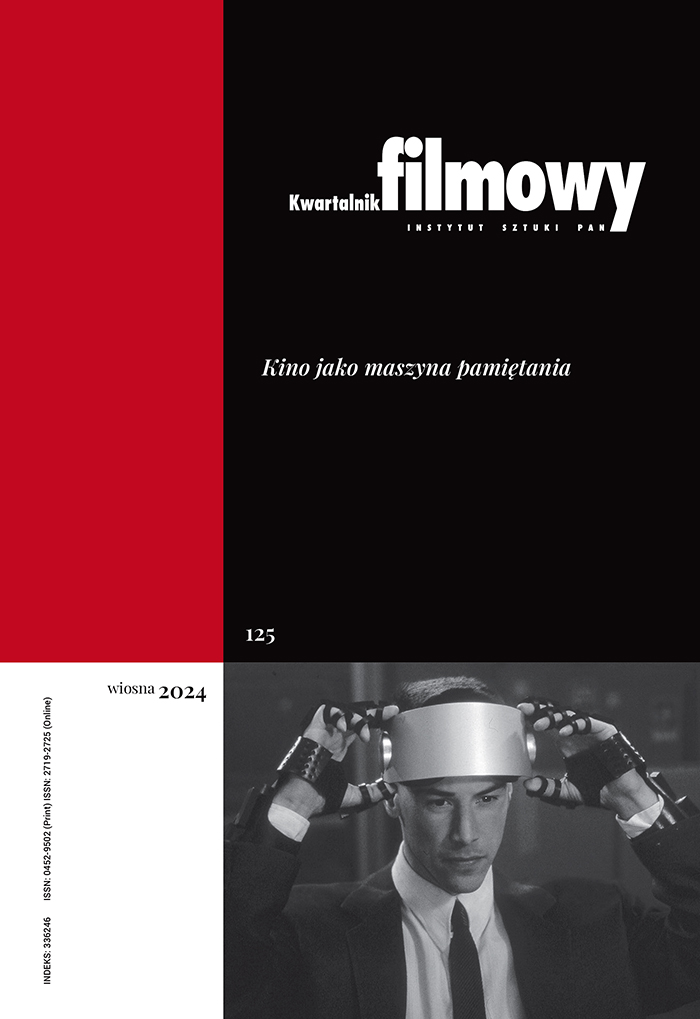Kolei filmowa moc
Abstrakt
Jak wspaniałym tematem filmowym mogą być koleje, dostrzegli już ojcowie kina, bracia Lumière. Od czasu ich Wjazdu pociągu na stację La Ciotat powstały setki filmów o parowozach, torach i pasażerach. Pociąg okazał się też nośną metaforą szybkości, mocy, ale i niepewności czy sytuacji bez wyjścia. Królem wśród filmów „kolejowych” pozostaje do dziś monumentalne Koło udręki Abla Gance’a z 1922 r. Jean Cocteau i Fernand Léger uważali, że historia kina będzie się dzielić na okres sprzed filmu Gance’a i po nim. Awangardowi filmowcy, Alexander Laszlo, Michaił Czekanowski i Jean Mitry, zrealizowali filmy eksperymentalne inspirowane obrazami pędzącego parowozu z Koła udręki i napisaną do nich muzyką Arthura Honeggera. Koleje dla kina to jednak coś więcej niż maszyna, atrakcyjny wizualnie, bogaty w znaczenia temat, nośnik idei. Mamy tu do czynienia z dwoma bliskimi sobie domenami ruchu. Taśma filmowa rozwija się w czasie jak tor kolejowy widziany z kabiny maszynisty. Każdy film jest w gruncie rzeczy podróżą pociągiem z punktu A do punktu B.
Słowa kluczowe:
pociąg, metafora kina, kolejBibliografia
Brzeski, Janusz Maria. 1932. Miasta, które czekają na swoich reżyserów, "Ilustrowany Kurier Codzienny". 29 XI 1932.
Google Scholar
Clair, René. 1984. La roue. W: N. King. Abel Gance: A politics of spectacle. London: British Film Institute.
Google Scholar
Cocteau, Jean. 1994. The Art of Cinema. New York.
Google Scholar
Dulac, Germaine Dulac. 1984. La roue: The song of the rails. W: N. King. Abel Gance: A politics of spectacle. London: British Film Institute.
Google Scholar
Gance, Abel. 1930. Prisme. Paris.
Google Scholar
Grabiński, Stefan. Ślepy tor. W: tegoż. Demon ruchu. http://literat.ug.edu.pl/grabin/0006.htm
Google Scholar
Léger, Fernand. 1970. Funkcje malarstwa. tłum. Joanna Guze. Warszawa.
Google Scholar
Autorzy
Marcin Giżyckikwartalnik.filmowy@ispan.pl
Rhode Island School of Design Stany Zjednoczone
Krytyk i historyk sztuki; autor książek z dziedziny historii filmu i zjawisk kultury artystycznej. Wykładowca w Rhode Island School of Design w USA. Opublikował m.in. Nie tylko Disney - rzecz o kinie animowanym (2000), Koniec i co dalej? (2001), Słownik kierunków, ruchów i kluczowych pojęć sztuki drugiej połowy XX wieku (2002), Wenders do domu! Europejskie filmy o Ameryce i ich recepcja w Stanach Zjednoczonych (2006).
Statystyki
Abstract views: 1189PDF downloads: 147
Licencja
Prawa autorskie (c) 2012 Marcin Giżycki

Utwór dostępny jest na licencji Creative Commons Uznanie autorstwa 4.0 Międzynarodowe.
Autor bądź autorka udziela wydawcy niewyłącznej i nieodpłatnej licencji (CC BY 4.0) na wykorzystanie tekstu w „Kwartalniku Filmowym”, zachowuje nieograniczone prawa autorskie i zobowiązuje się do podawania miejsca pierwodruku przy ponownym wykorzystaniu artykułu (umowa licencyjna do pobrania). Czasopismo jest wydawane na licencji CC BY 4.0. Zgłaszając artykuł do publikacji, autor bądź autorka wyraża zgodę na jego udostępnianie na tej licencji.
W wydaniach od 105-106 (2019) do 119 (2022) wszystkie artykuły były publikowane na licencji CC BY-NC-ND 4.0. W tym okresie autorzy i autorki udzielali(-ły) niewyłącznej i nieodpłatnej licencji (CC BY-ND 4.0) na wykorzystanie tekstu w „Kwartalniku Filmowym”, zachowywali(-ły) nieograniczone prawa autorskie i zobowiązywali(-ły) się do podawania miejsca pierwodruku przy ponownym wykorzystaniu artykułu.
Inne teksty tego samego autora
- Marcin Giżycki, Smartfon – tryumf Eisensteina , Kwartalnik Filmowy: Nr 112 (2020): Polski dokument, polska animacja
- Marcin Giżycki, … Zostały tylko fotosy. Nieistniejące filmy Cindy Sherman , Kwartalnik Filmowy: Nr 115 (2021): Film formy, film treści
- Marcin Giżycki, „Złoty wiek” – arcydzieło prowokacji , Kwartalnik Filmowy: Nr 109 (2020): Przestrzeń architektoniczna w filmie
- Marcin Giżycki, Ostatni czarnoksiężnik zachodniego świata , Kwartalnik Filmowy: Nr 34 (2001): Kino przełomu wieków
- Marcin Giżycki, Dlaczego nie lubię reklam w kinie , Kwartalnik Filmowy: Nr 105-106 (2019): Kino wobec transformacji ustrojowych
- Marcin Giżycki, Kino rozszerzone po trzydziestu latach , Kwartalnik Filmowy: Nr 35-36 (2001): Kino i nowe media
- Marcin Giżycki, Blaski i cienie animacji w Bohemii , Kwartalnik Filmowy: Nr 81 (2013): Dziecko i film
- Marcin Giżycki, Magiczne początki kina , Kwartalnik Filmowy: Nr 74 (2011): Rzeczy filmowe
- Marcin Giżycki, Zemsta Jokera i pasożytów , Kwartalnik Filmowy: Nr 108 (2019): Produkcja i dystrybucja filmowa
- Marcin Giżycki, Tucker i inni , Kwartalnik Filmowy: Nr 110 (2020): Poza człowiekiem











